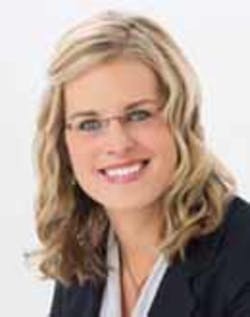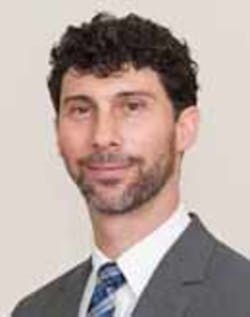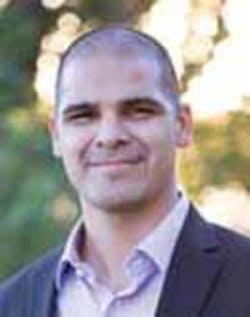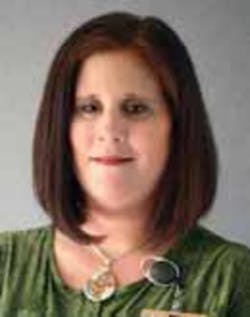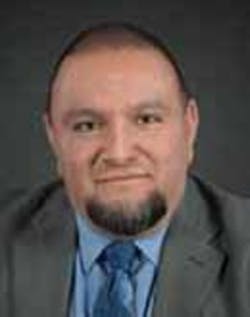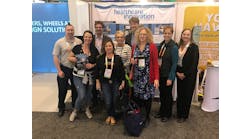Healthcare IT is field that is continuously growing, so it isn’t a surprise that the industry is filled with rising stars. The men and women interviewed in this piece were nominated by their peers for the strides they’ve made thus far in their HIT career. Daniel Stein, MD, PhD; Emily Templeton; Jacob Garcia; Jimmie Romero Jr; and Krista Bohlen are all worthy of our praise for the work they are accomplishing in a time where it feels like technology is advancing faster than can be kept up with. Continue reading for their thoughts on the challenges in the field, the future of HIT, their advice for HIT professionals, and more.
What’s your background up to your current role?
As a pharmacist by training, I have been fortunate to work in unique positions ever since graduating from pharmacy school—including my current position as Director of Personalized Pharmaceutical Medicine at Avera Institute for Human Genetics. During my PGY1 residency at Mayo Clinic, Rochester, MN, pharmacogenomics (PGx) was ordered on individual patients, and as a pharmacist, I assisted with Medication Therapy Management (MTM) recommendations utilizing this information. I joined Avera as a Research Pharmacist and spent the majority of my time initially with oncology NCI and industry-sponsored trials and eventually transitioned solely into pharmacogenetics. I worked closely with our laboratory at the Avera Institute for Human Genetics and learned a lot as we translated rows and rows of microarray data to an insightful clinical report.
What has been the hardest project you have worked on to date? What did you learn from it?
Implementing pharmacogenomics into the EMR and utilizing medications and clinical information to help providers with PGx consultations with possible drug-drug-gene interactions. EMR’s were not designed to handle the vast amount of genetic data that is now available and certainly will grow with each patient. Thankfully we have innovative and multidisciplinary staff within AIHG, the EMR analyst team, and LIS team, as we all had to be very creative in manipulating existing infrastructure and spinning it to work for PGx structured laboratory results and reports. We learned that the best implementation is not through each and every EMR and that we needed a cloud-based technology to broadly implement PGx.
What is the biggest challenge in healthcare IT today? Any ideas on how to solve this challenge?
We have the capacity for so much, but we also have to respond to fluctuations in reimbursement and payer structures which requires new data, new approaches, swift actions/responses, etc.—detracting attention from new technologies and innovations. We must continuously triage our efforts to stay ahead, dream of new ideas, take swift action and build the next great innovation.
What advice do you have to give to those looking to enter the healthcare IT space?
Gain clinical experience first or alongside your healthcare IT training. You have more rapport with healthcare professionals if you’ve been the boots on the ground and can relate to their challenges. You are more valuable with an understanding of the implications and challenges to provide complementary technology and minimize the risk of disruptive technology and unintended consequences.
What do you hope will be accomplished in the healthcare IT space in the next five to 10 years?
Don’t we all wish for a universal EMR with universal pharmacy and insurance claims to understand what the patient does, as compared to what they’re prescribed to do? I think we’ll see automated speech recognition devices in patient rooms to alleviate transcribing and writing notes. With further investigation and protection, I would love to have secure universal cloud access of genetics data to use as new conditions are encountered by the patient, and thus new prescriptive needs which can be as mobile as our population.
What’s your favorite piece of technology?
I really enjoy digital SLR cameras, as I find myself lost in nature or capturing a family moment in time. I need to be still to recharge and a camera proves to be a great tool.
What’s your background up to your current role?
After medical school I took a “if you don’t like it, change it” approach to Health IT. I found it frustrating that electronic health records (EHRs) were clearly designed for something other than helping clinicians take care of patients. At the time I didn’t even know there was a field of study for Biomedical Informatics, but I quickly discovered, applied for, and received a National Library of Medicine fellowship to study the subject in the Department of Biomedical Informatics at Columbia University. It was supposed to be a two-year stint that would result in a master’s degree. Toward the end I found that I enjoyed the faculty, students, and research so much that I decided to transfer into a PhD track and really dive deep into how to design, implement, and evaluate new tools that help clinicians provide patient care in safer, more effective ways. Upon completing my dissertation, I stayed on at Columbia as a junior faculty member for a few years before moving to the other side of NewYork-Presbyterian Hospital (Weill Cornell Medicine). This allowed me to see things from a different perspective and prepared me for my current position—leading the Clinical Informatics Innovation team at Memorial Sloan Kettering Cancer Center.
What has been the hardest project you have worked on to-date? What did you learn from it?
I think the project I’m currently working on has been the hardest so far. I’m working with my team to solve a set of challenges around modernizing the way teams of clinicians collaborate and communicate. We’re trying to help them sort through who the members of a given patient’s care team are, who might be covering for each of them at any given point in time, and how to get in touch with them in a fast, reliable, closed-loop manner. Even in a place like New York City, many of the most high-tech and sophisticated healthcare institutions are still dependent on ancient technology like pagers and fax machines to communicate. Many cognitive cycles are spent trying to figure out who has been taking care of this patient in the outpatient setting, who is the fellow on call this weekend for this consult service, who should be paged next when the intern is not responding, etc. The fragmented nature of collaborative patient care is even more exasperating when viewed in contrast with the social tech we have in our everyday lives that keeps us intimately connected with our friends, family, and even people we barely know … why is it so hard for clinicians to adopt modern technology to stay on the same page?
What I’ve learned from working on these challenges is that swapping out fundamental tools used in clinical care is hard, and not just because some clinicians don’t like change, or because there are privacy challenges regarding new communication tech in healthcare (though these factors are significant as well). Clinically-trained individuals are very good at making things work and making the best of the tools and tech that they have on hand. This often results in years or even decades of adaptations and accommodations that can lead to highly complex but highly reliable ways of getting the job done. When you try to disrupt that, sometimes you find that what seems like a simple change (e.g., swapping antiquated pagers for smartphones), would disrupt layers and layers of adapted workflow and therefore is very difficult to orchestrate. You almost have to start over from the ground up—and doing that while patient care keeps going can seem near impossible. I’ve also learned that the first time a new tool doesn’t work as reliably as the old one (e.g., a text message to a smartphone is delayed, as compared to receiving a page), there is instant rejection—even if there are other clear benefits to making the switch. Again, this contrasts with our tolerance for these types of inconsistencies in everyday lives—how many of us would throw away our smartphones and go back to landlines because of some spotty performance now and then? To me, these types of problems are the best ones to chip away at with the methods of Informatics, as they require deep understanding of the people, processes, and the technology to make a significant impact.
What do you like to do off-the-clock?
The hours on the clock are substantial, so when I’m off, I focus on spending time with family. If the weather is good, we try to do that in the great outdoors as much as possible, given the time spent working in the metropolis of NYC. When it isn’t, gaming is a mainstay, whether with dice and cardboard on the tabletop, or on the couch with my kids on one of our video game consoles. I’ve been known to make the argument that my interest in video games is fueled by a desire to prepare our kids for the modern workforce (coding, multitasking, collaborative tools, strategy/tactics, etc.) and a desire to study the complexity and nuance of user interfaces as exemplified by modern game design. Make of that what you will!
What’s your background up to your current role?
I first became interested in healthcare while enrolled in a high school human physiology and anatomy class. During this time, our local hospital was recruiting for nurses, but my interests leaned more toward computer hardware and networking. I was lucky that my neighbor, who owned a small IT consulting company, had already taught me the basics of IT as a teenager. Armed with this knowledge and inspired by a newfound interest in healthcare, the hospital hired me as an intern in their computer operations department and the rest was history! Almost 20 years later, I have had the opportunity to sit in every role from helpdesk intern to chief information officer.
In your opinion, what’s the most interesting thing going on in healthcare IT today?
I’m going to jump on the Artificial Intelligence bandwagon. There are so many applications for AI that will revolutionize healthcare, allowing us to gain unique insights into the diagnosis and treatment of patients. AI will redefine how we process and protect data, increase the intelligence of our medical devices, and extend our reach for access to healthcare across the globe.
What is the biggest challenge with privacy and/or security today?
People. We live in an increasingly interconnected world and to quote an old TV show, “You are the weakest link!”
Any ideas on how to solve this challenge?
Education and added layers of defense. My company, Trum Partners, specializes in protecting the most vital asset within the healthcare market today—data. People always come first, but protecting your data, whether it be patient or business related, is an aspect of security and privacy often overlooked today. Data is truly “the lifeblood of an organization.” Maintaining the integrity and availability of that data is critical.
What advice do you have to give to those looking to enter the healthcare IT space?
Buckle up, because many organizations are trying to go warp-speed! Healthcare IT has historically been a lagging industry and an underserved market over the past few decades. Today, in a thriving economy, and set on a more digital infrastructure, healthcare organizations are pushing the envelope. We are now experimenting with new tools and more data than ever to provide enhanced treatment and better patient outcomes.
What’s your favorite piece of technology?
I’m simple, I like my Apple Watch. Not because it can tell me my heart rate, or reply to an email, but it frees me from my phone to go for a run or a bike ride. The times I do use it for a quick call, I feel like the modern day Bond or Dick Tracy.
What do you like to do off-the-clock?
I took a sabbatical just this last year on an adventure around the world! It was extraordinary, life-changing, and a truly humanizing experience. I traveled back in time through the Amazon jungle, tested my physical body trekking the Himalayas to Everest, and attended a class with the Dalai Lama. I learned whether mental or physical, health equals wealth. Everyone deserves their version of “the best life,” and it is truly my motivator for working in HIT.
What is your background up to your current role?
Over the past 24 years, I have literally grown up working for the physicians that I currently work for today. Since 1994, I have worked for two of the pediatricians that I saw as a child. I have watched the clinic that I originally began working for grow from a single clinic with four physicians to eight clinics with 35 providers (27 physicians and eight nurse practitioners). Although I started out my career as an LPN, I currently act as the electronic health record (EHR) software administrator for approximately 150 end-users.
In 2002, the company decided to implement our first electronic medical record (EMR). Up until that time, the only computers in the office were in the front office to schedule appointments and to enter payments. Nurses and providers documented everything on paper. I was always afraid to do much with computers in the past, so the thought of having to use a computer all the time was very intimidating. However, once I started learning about the EMR software, the more I wanted to learn. I began “playing with the software” every chance that I had, and quickly became the most experienced user. Over the next year, I became the person who called the software company with questions and gradually became the person to call in other locations when nurses and providers had a question or a problem. It became almost impossible to continue working as an office nurse as well as be the “go-to” person for EMR questions. The company collectively decided to offer me a position as the fulltime EMR trainer for all locations. I was sent for superuser training and began writing EMR procedure manuals for providers and nurses which contained suggested workflows.
Then, I was encouraged by my best friend and co-worker to go back to school to obtain a Bachelor of Science in Health Informatics degree. I was able to take what I had previously learned and significantly enhance my knowledge base that has helped me take my current position to the next level. Additionally, I have obtained the Certified Professional Coder certification through AAPC as well as CompTIA Project + certification, and the CompTIA Healthcare IT Technician certification. I graduated from Western Governors University in August of 2017 with a BSHI degree and obtained the Registered Health Information Administrator (RHIA) certification in November 2017. I recently completed a new outpatient documentation course offered by AAPC and recently obtained the Certified Documentation Expert Outpatient (CDEO) certification in September of 2018.
What were your fears concerning technology? How did you overcome these fears and embrace technology?
When my husband and I bought out first home computer in 1997, I was always afraid that I would somehow break it or mess it up—so, I just didn’t touch it much. However, when my company implemented our first EHR, I literally became fascinated with learning about the functionality. I also quickly learned to start thinking “outside of the box” to find ways to capture the correct information as efficiently as possible. It quickly became a running joke about how providers “count clicks.” I loved to figure out workflows that would allow providers and nurses to efficiently perform their jobs. I also learned the importance of the appropriate use of templates and “set-all” buttons—which allow providers to bring in a lot of information with one click. This type of functionality can be a curse as well as a blessing—I want to train staff to use templates responsibly, as well as improve efficiency.
I also had the unique challenge to make sure that the providers were able to depend on me to know the answers to their software questions. This required me to dig in and really learn how the software worked and to not be afraid to make mistakes. I would check in a test patient in the software and continue to try different workflows until I was able to find the most efficient one. The more I played with the software, the less I was intimidated by it.
In your opinion, what’s the most interesting thing going on in health IT today?
I am interested to see how a national infrastructure of passing health information is slowly starting to come together. We are starting to significantly use direct messaging to pass health records electronically from one provider to another. We are also able to receive CCDA documents from hospitals and healthcare centers at the point of care, which can prevent duplicating labs and tests that may have been done at another location. It also allows providers to obtain medical information without having to wait hours or days for another facility to fax the information which can potentially delay patient care.
What advice do you have to give to those in the healthcare IT space?
I feel the best advice that I could give someone in healthcare IT is: Try to stay on top of all of the changes that are going on in the healthcare landscape as much as possible. Healthcare IT is definitely one of those fields that seems to be constantly changing, and the more you know the better off you are.
What is your favorite piece of technology?
I would have to say that the use of the iPad for patient kiosk check-in has significantly streamlined the patient check-in process. We use the kiosk to allow parents to complete patient questionnaires in the waiting room, which has significantly decreased the time it takes a nurse to check-in a patient. It also allows our teenage patients to answer personal information—such as depression, drug, alcohol screenings—on the iPad versus asking them on paper, which would need to be manually scanned into the system or verbally asking the questions. Teenagers are very comfortable with technology and tend to be more honest when answering questions on an iPad than on paper or being asked verbally.
Jimmie Romero Jr.,
Information Systems Admin Tech II,
Mt. San Rafael Hospital, Trinidad, CO
What has been the hardest project you have worked on
to-date?
I would have to choose the Virtualization project with single sign-on that is still ongoing within our organization.
What did you learn from it?
I learned the importance of protecting the patient’s information by being able to install another safeguard in the protection against cyber criminals and social engineering within the organization.
In your opinion, what’s the most interesting thing going on in healthcare IT today?
I feel the most important thing in healthcare today would be predictive analytics machine-learning within big data. Being able to predict when the bad guys are trying to access the organization’s systems—before they actually gain access—is absolutely beneficial!
What is the biggest challenge in healthcare IT today?
I believe that cybersecurity is the biggest challenge facing healthcare today, because of the lack of education, resources, and lack of awareness organizations are facing. This is even more of a task being in rural areas.
Any ideas on how to solve this challenge?
Cybersecurity is not just an IT problem, but a business problem. Awareness training is not just for IT personnel, but for all employees who have access to a computer and the internet. The focus of awareness training needs to be tailored to each employee’s role within an organization. Cybersecurity needs to be part of an organization’s culture to be effective, if it is just a checkbox approach—which employees don’t understand what it is about and why it is important—the training will surely be ineffective. The most important safeguard to any kind of cyberattack is education! Awareness, education, and repetition in both are always going to be beneficial in the asset protection and information assurance of any organization.
What advice do you have to give to those looking to enter the healthcare IT space?
My advice would be to be an out-of-the-box thinker, an innovator a trailblazer. Always strive to make a difference in healthcare! We may not have direct interaction with patients, but what we do directly affects patient care!
What do you hope will be accomplished in the healthcare IT space in the next five years?
I would hope to see a resolution to the problem plaguing healthcare IT, which is lack of interoperability between health systems.
What’s your favorite piece of technology?
With all the introductions of so many different pieces of technology becoming readily available, if I had to choose one, I would choose Artificial Intelligence.
What do you like to do off the clock?
I have several different hobbies that I enjoy on my time off. I enjoy music a great deal! I enjoy listening to music as well as playing music, I play several instruments, including guitar, bass guitar, drums, and some piano. I also enjoy spending time with family and friends!

